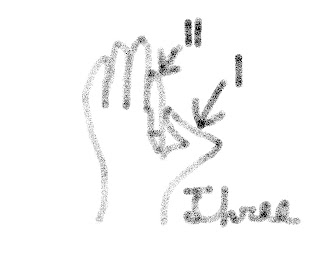Stroke notation: IIII II
Saturday, October 31, 2009
Friday, October 30, 2009
Five
Stroke notation: IIII I
(Any questions? Please feel free to ask... (although, I must admit, I've heard the one about "practical applications" quite a few times already, and can assure you that - in my experience - there have been no shortage of them))
Thursday, October 29, 2009
Tuesday, October 27, 2009
Three
That's right! 1 + 2 = 3. In our case, that's our index finger plus our thumb. Here it is in stroke notation:
II I
Two
So, in summary, we are giving our thumb a value of "one" when pulled in, and our index finger a value of "two" when pulled in. In stroke notation:
II
Any ideas how we would get "three"...? (Hint: _ + _ = 3...)
Wednesday, October 21, 2009
"One"
OK! Let's start counting... We pull in our thumb and call it: "One", like this:
In stroke notation:
I
Well, folks, that's all for tonight (or is that really early this morning!?) ;) I cannot wait to show you more, but I must go for now...
"Getting the Word Out"
I decided I would "hearken unto counsel" and keep getting the word out on Binary Finger Counting. What is it? It is, simply, doing more with less. The majority of us have five digits on each hand. What we do with them, however, in terms of counting is actually pretty simplistic. Basically, each digit is a assigned a value of "1", and then added together. So, for example, one extended finger (usually our index) respresents "One". Two extended fingers (such as our index and middle fingers) is considered to represent "Two", and etc. until all five digits are extended, which we typically consider to mean "Five".
This is, however, only scratching the surface of the potential we have. Let us start with our five digits all extended and, as a matter of fact, assume that to be "Zero" (!)
More later...
This is, however, only scratching the surface of the potential we have. Let us start with our five digits all extended and, as a matter of fact, assume that to be "Zero" (!)
More later...
Subscribe to:
Posts (Atom)






